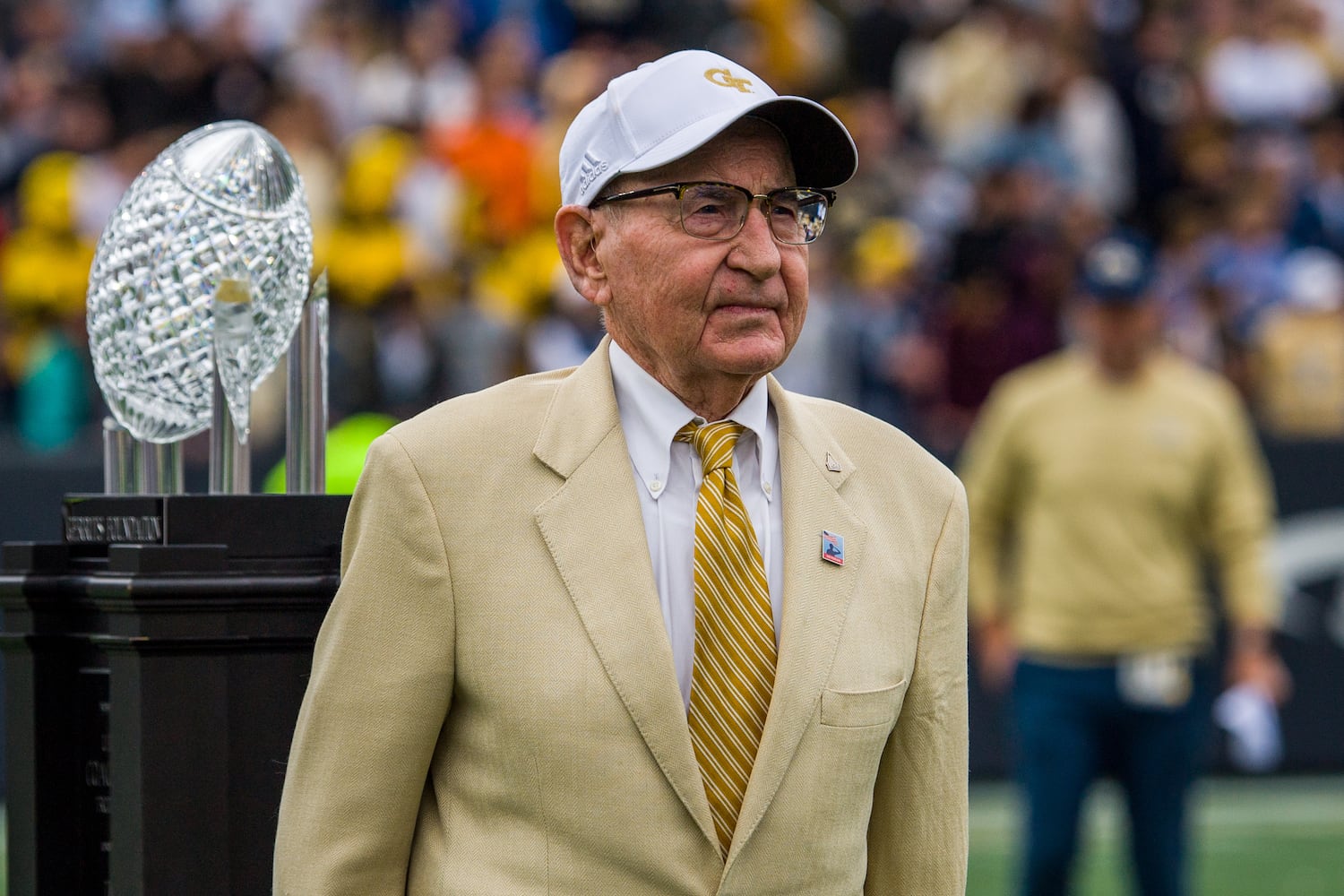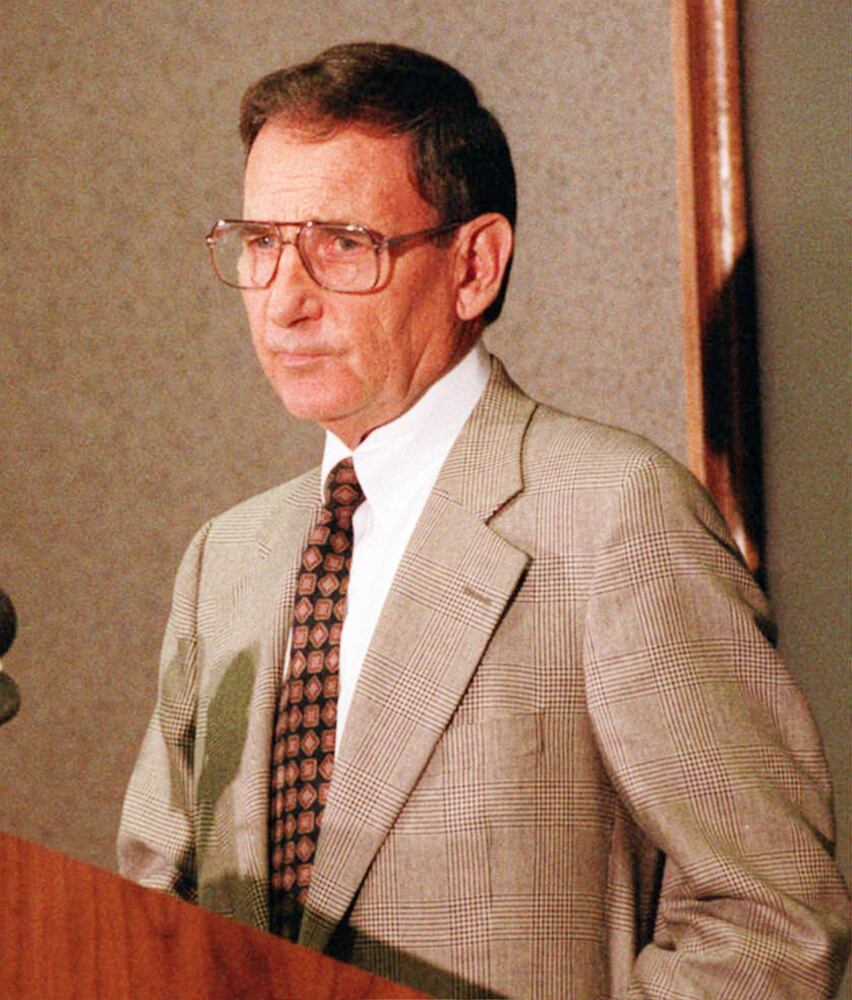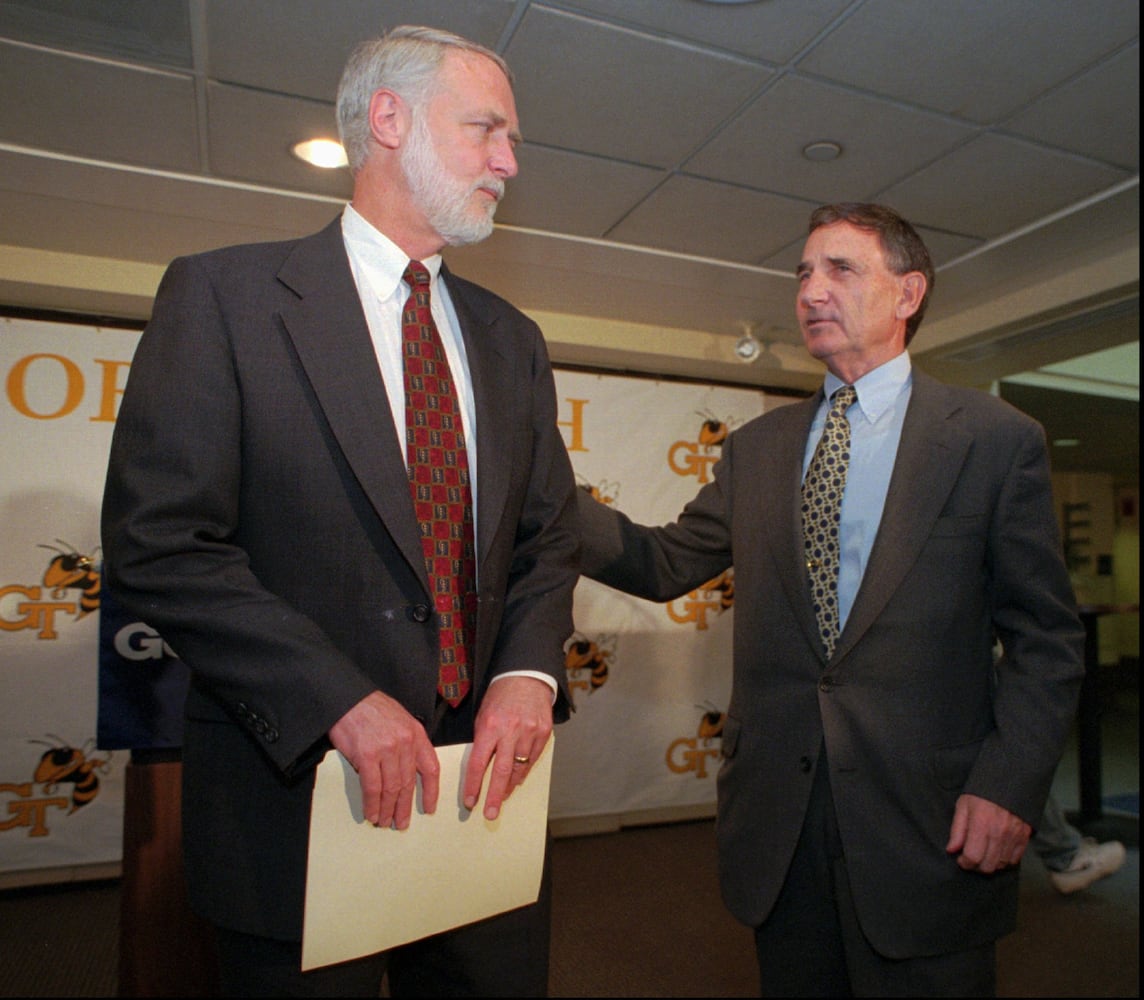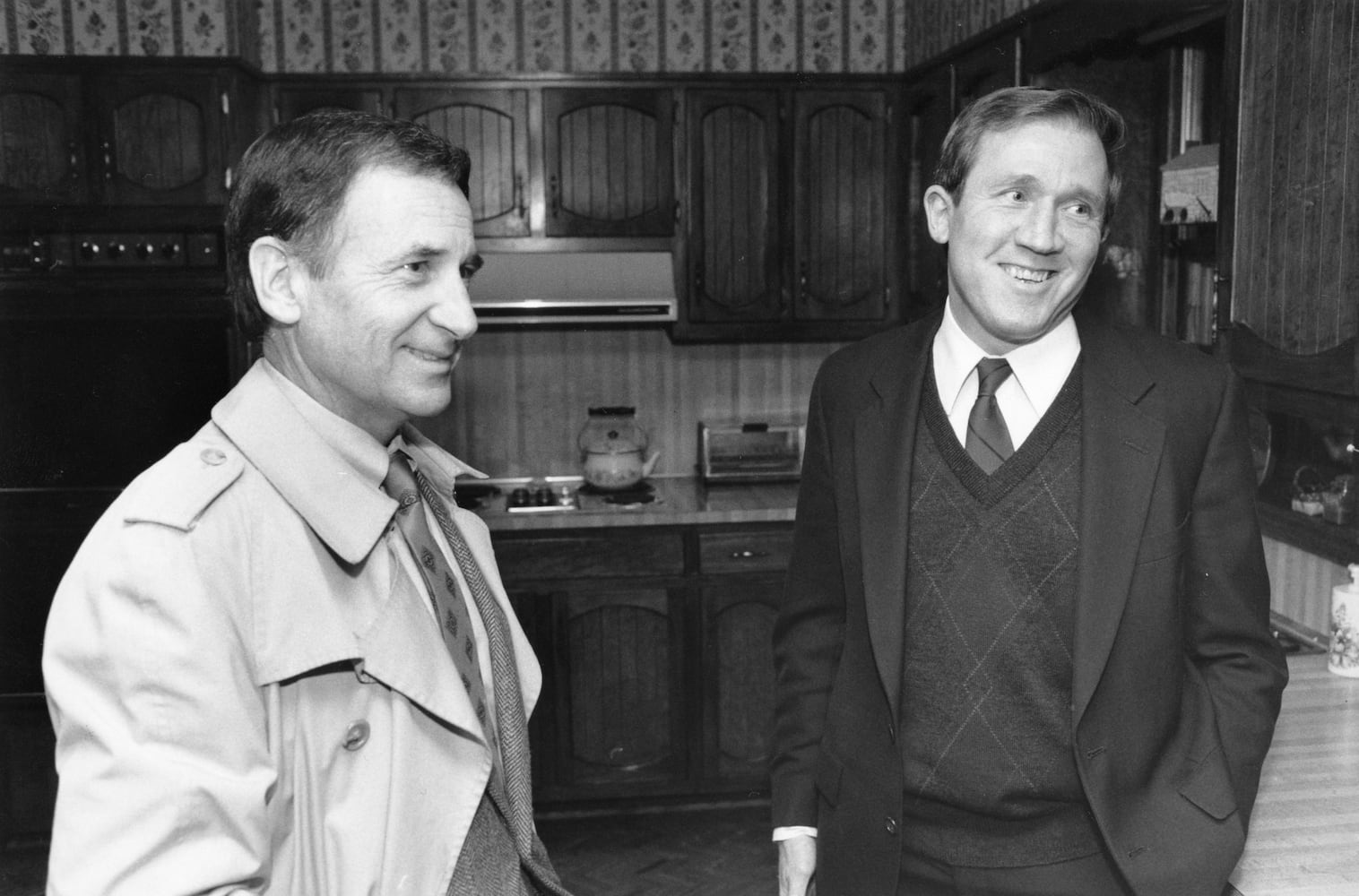When considering Homer Rice’s legacy at Georgia Tech, there’s a little something for everyone, for both the hardened pragmatist and dreamy idealist. Because Rice, who died Monday at the age of 97, so naturally worked both sides of that street.
He was part program-builder, arriving at Tech in 1980 and sparking a sporting renaissance on The Flats during his 17 years as athletic director. Where before him there was a football team that teetered on irrelevance and signs of dry rot throughout the athletic department, there followed one of the golden periods of Tech athletics. Highlighting Rice’s reign was a football national championship, a men’s basketball Final Four appearance – both in 1990 – and six different programs enjoying at least some time atop the national rankings.
And part person-builder, who dared step beyond the often cynical, win-today realm of college athletics and advocate for a player’s long-term well-being beyond the field. His “Total Person” program, which stressed life skills, career planning and self-improvement, was the model for a similar course later launched by the NCAA.
Make no mistake, Rice served the bottom line of winning. “When he took that job in ‘80, Georgia Tech was probably as low as it has ever been and will never be again, whether it was facilities or funding,” said Bernadette McGlade, one of Rice’s initial hires at Tech as its women’s basketball coach, now the commissioner of the Atlantic 10 Conference. “He literally reinvented and rebuilt an entire academic institution’s athletic program.”
As Rice put it succinctly in early 2023: “We were able to put some money together and some wins together and one by one, we moved it forward and gained a lot of success.”
But he also reached deeper into the athlete, past the fast-twitch fiber to the mind and spirit, to where the ever-fading ideal of college athletics lives.
“His most important legacy is in the education and self-esteem the student-athletes earned by going through his program,” said Bill Curry, the football coach hired just before Rice’s arrival who spent the 1980-86 seasons there before leaving for Alabama. “If you took the Total Person program it affected everything else in your life and made a difference in your life. I think that’s Homer’s gift.”
So committed was Rice to the educational component of his life that he taught a Leadership Fitness class to the general student body at Tech well into his 90s, the students often enjoying a dinner on the coach after class.
Filling out muscle and mind were equally important to the AD. Curry learned that lesson soon after his new AD showed up on the Tech campus, when asked by his boss not how practice was going but rather how his Total Person sessions with the team were progressing.
Rice received a lukewarm answer. “We were working on recruiting and short yardage and goal-line, two-minute drill, football stuff,” Curry recalled.
“I’ll get around to it,” Curry told Rice.
“No, you didn’t understand what I said,” Rice shot back. “Here’s what we’re going to do. Thursday at 11 all of the football team will be in the team meeting room, and I’ll be on the front row, and you will teach the Total Person program for an hour. I’ll see you then.”
Now 81 years old, Curry still can quote each of the seven pillars of the “attitude technique” that Rice devised as part of his developmental program, from “making the commitment,” to “giving of yourself sacrificially,” to “believing in yourself, believing in your team, such that your belief is unshakable.”
Homer Cranston Rice was born Feb. 20, 1927, in Bellevue, Kentucky, the son of a Methodist minister and a second-grade teacher. And, true to his bloodlines, he would be for all his years a preacher and teacher.
He often told the story of being preternaturally interested in the idea of personal success, ruminating on that subject at an age when most boys are just obsessing over the various eruptions of acne and body hair. His father had given him a book on goal-setting when Rice was only 12, entitled “I Dare You.” Wrote Rice in his “Leadership Fitness” book: “It stimulated me to search for the secrets to successful living.”
As with most coaches, Rice had the athletic part of the program pretty well covered. In high school in Fort Thomas, Kentucky, and at Centre College (Danville, Kentucky), he was the star quarterback. He could play just about any sport, and did just that back in high school.
The games were interrupted, however, by WWII. At just 17, Rice joined the Navy near the end of the war, just in time to hop a supply ship to the Philippines and dodge Japanese sniper fire while running goods to troops there. Not all the mementos of his life are football related.
“We were traveling in this truck with supplies, and we were being shot at several times,” Rice once recalled. “The chief was really something, this tough old guy. He said pull over. And he tackles a Japanese officer, takes his bolo knife and hands it to me and says, ‘Here, hold this.’ And I still have that knife.”
Malaria cut short his Pacific duty, and could have cut short his life. Five other servicemen in his hospital ward at the time didn’t recover.
Football welcomed the recovered Rice back home, as he played it at Centre College and coached it at the high school level after graduation. Once out on his own, he immediately demonstrated a knack for building with whatever tools were handy.
His 1950 posting at Wartburg (Tennessee) Central High School was an impoverished one, the football team sorely lacking the basic equipment. Knowing that the nearby prison fielded a football team, Rice turned to it for help. The warden agreed to supply shoulder pads, helmets and the like in return for Rice’s help coaching the prison team.
In one magazine story, he later joked that it was one of his best coaching gigs of all, since every game was a home game and he never heard a peep from the alumni. Every time he heard a police siren, he said to himself, “I hope they pick up a tight end or a speedy running back.”
Both his high school and his prison teams went unbeaten that year.
A gaudy record as a high school coach – he calculated it to be 102-9-7 over 10 years at three stops in Tennessee and Kentucky – greased the way for promotion. At 40, straight from working on the triple-option as an assistant at Oklahoma (he literally wrote the book on triple-option football), Rice got his first college head coaching job, at Cincinnati.
Eleven years later, after one detour as athletic director at North Carolina and serving as head coach/AD at Rice, came the chance to coach at the highest level. Well, sort of. His NFL coaching opportunity came with the then-moribund Cincinnati Bengals. Consecutive four-win seasons followed in 1978 and ‘79.
A 1979 Sports Illustrated article detailing the woes of those Bengals only briefly addressed the coaching, and then it was more fashion statement than serious slam of Rice’s on-field acumen: “Critics call for more intensity from Coach Homer Rice, a pleasant, low-key fellow who grew up in the Cincinnati area and also coached high school and college ball there. Rice wears a business suit on the sideline, ‘as though,’ one indignant fan says, ‘the game were a stopover before a cocktail party.’”
Rice’s win-loss record had fallen off – 12-28-1 in college, 8-19 in the pros – but the goodwill he built as an administrator and motivational figure never dimmed.
Curry said that both he and then-university president Joseph Pettit from the beginning had targeted Rice as their guy to fill the athletic director opening at Tech in 1980. For his part, Rice wasn’t so sure. Reports were that Paul Brown, part owner of the Bengals, a mentor that Rice had first met in Navy training, was set on retaining his coach. And while eager to implement his Total Person concept at the collegiate level, Rice was uncertain Tech was the place to do that.
“We unleashed our secret weapon,” laughed Curry, referring to the iconic former Tech coach and AD Bobby Dodd, who had retired four years earlier.
“Every sport was losing,” Rice remembered in early 2023. “Bobby Dodd is the one who convinced me to come. He said, ‘You got to come, we’re going to drop football.’ I don’t know if that was true or not, but it was close to that.”
Indeed, the bellcow sports of football and basketball had fallen into a deep sinkhole. The football team had been to one bowl game in the previous seven seasons (and it would require Curry four more years to make it back to one).
Said Curry, “Coach Rice would joke with me: ‘Coach Dodd talked me into coming down and visiting and lo and behold I ended up taking the job. Then I watched your first spring practice and I called my wife and said, don’t start packing yet.’”
Oh, and the basketball team had won all of a single ACC game in two seasons.
The building job would be a from-the-ground-up proposition. For facilities had gone to seed relative to the rest of big-time college sport.
Curry said he was under orders from his new AD not to let any recruiting prospect or their parents visit the Tech locker room. “It was the same locker room as when I played there in 1960 and the same locker room that the 1942 team had dressed in,” Curry said.
“Our weight room was an outdoor deal surrounded by chicken wire under the north stands,” he said.
Added Curry, “It was desperate. We were at the lowest point we had ever been. We were surrounded by difficulty.”
Fortunately Rice was equally adept at shaking the money tree and hiring good coaches.
Slowly the facilities were brought up to collegiate code.
And look at the coaches he brought in during just a one-week span: Bobby Cremins, who would take that lost basketball team to 10 NCAA tournament appearances, including one Final Four. Jim Morris, who took Tech baseball to nine consecutive regionals before winning two College World Series at Miami. And McGlade, just a 23-year-old North Carolina grad assistant at the time, who laid the foundation for Tech’s women’s basketball program just as it was being folded into the NCAA.
Rice’s powers of persuasion and presence could be irresistible.
As Cremins remembered the wooing process that preceded his move from Appalachian State: “(Rice) had a vision. And he had been there. He had been big-time – college football, NFL and athletic director at North Carolina. I felt very comfortable with him.”
The personal touches didn’t hurt, either. “He saw me play (at South Carolina) and told me he always remembered me making clutch free throws against North Carolina when we beat them in Chapel Hill. We had a good laugh about that,” Cremins said.
Those gifts extended to teenagers as well. Mark Price’s signing in 1982 was a major turning point for the basketball program (Price was a two-time All-American who led the team to an ACC title his junior year). A long conversation between Rice and the young recruit on how much Tech and the Total Person program could shape Price’s future was pivotal to the signing, Cremins said.
McGlade, who went on to oversee a variety of sports at Tech, both men’s and women’s, before becoming a conference commissioner, is living testimony to Rice’s philosophy of empowering those who worked and played for him.
“He wasn’t concerned about putting a female in a senior associate athletic director position overseeing football and men’s and women’s basketball and the Olympic programs,” McGlade said.
“He catapulted my career. It was as much a risk for him to hire me as it was a risk for me to take the job at 23. He not only hired me but allowed me to be in an environment that made me successful. Being supportive and helping me develop my leadership skills and being committed to my professional development. And also being able to finance the program.”
Not every hire would be a home run. The same guy who hired Cremins and Morris and McGlade and Bobby Ross (who won the football national championship in 1990) and George O’Leary and successful golf coaches Puggy Blackmon and Bruce Heppler and longtime women’s basketball coach Agnus Berenato also hired Bill Lewis. Lewis’ Yellow Jackets football teams went 11-19 between 1992-94 before O’Leary came to the rescue, first as an interim, then full time. On balance, though, Rice’s eye for coaching talent seemed raptor keen.
Rice was a success beacon, radiating it the way a WSB tower emits radio waves. All a person had to do was be ready to receive.
“Me personally, he gave me freedom to do my thing. Although, he used to tell me, ‘You’re the only guy I know who can break an unlimited budget,’” Cremins said.
“He gave me a lot of advice, a lot of resources. At the ACC spring meetings he always wanted to meet with me for an hour. He said tell me exactly what you need, what is the most important thing to you? And he would do all he could to get those resources to help me.”
Three athletics figures have been deemed statue-worthy on the Georgia Tech campus: John Heisman, Dodd and Rice, who is 7-feet tall and cast in bronze in the shadow of the sports-performance building that bears his name. All three have big-time awards named after them – Heisman (most outstanding collegiate player), Dodd (college coach of the year), Rice (athletic director of the year). Their names have all been transformed into synonyms of success.
Perhaps the greatest compliment one could pay Rice, though, is that the husband, father to three, grandfather to seven, great-grandfather to four and wise counselor to generations of those who crossed his path at Georgia Tech had lived a total life. Rice was preceded in passing by his wife of 64 years, Phyllis, who died in 2013. He is survived by three daughters, Nancy Hetherington, Phyllis Ingle and Angela Miller and his wife Karen, whom he married in 2015.
Did we forget to mention that besides rebuilding one slightly ramshackle athletic program in Atlanta, Rice in his day also was a Golden Gloves boxer, played trumpet in a swing band and sold insurance like his next meal depended on it to supplement meager high school coaching pay?
“He embodied the Total Person concept,” McGlade said. “He was so dedicated to his profession, so dedicated to his family and he was so dedicated to his Christian beliefs. And he was not shy about any of the three of them.”
About the Author
Keep Reading
The Latest
Featured





